The Intel Haswell Refresh Review: Core i7-4790, i5-4690 and i3-4360 Tested
by Ian Cutress on May 11, 2014 3:01 AM ESTReal World Benchmarks
2D to 3D Rendering –Agisoft PhotoScan v1.0: link
Agisoft Photoscan creates 3D models from 2D images, a process which is very computationally expensive. The algorithm is split into four distinct phases, and different phases of the model reconstruction require either fast memory, fast IPC, more cores, or even OpenCL compute devices to hand. Agisoft supplied us with a special version of the software to script the process, where we take 50 images of a stately home and convert it into a medium quality model. This benchmark typically takes around 15-20 minutes on a high end PC on the CPU alone, with GPUs reducing the time.
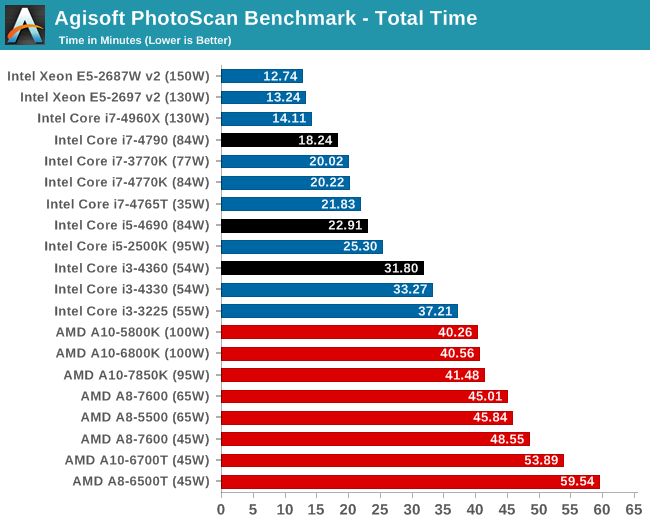
For Photoscan we see the incremental speedup with the i3 models, but the increased single thread speed of the i7 makes more of a difference.
Compression – WinRAR 5.0.1: link
Our WinRAR test from 2013 is updated to the latest version of WinRAR at the start of 2014. We compress a set of 2867 files across 320 folders totaling 1.52 GB in size – 95% of these files are small typical website files, and the rest (90% of the size) are small 30 second 720p videos.
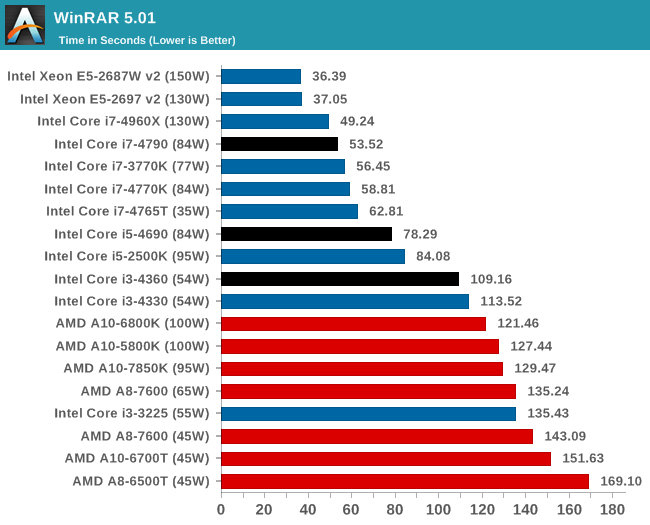
For WinRAR, the increase in the threads makes the most difference here, moving from i5-4690 to i7-4675T.
Image Manipulation – FastStone Image Viewer 4.9: link
Similarly to WinRAR, the FastStone test us updated for 2014 to the latest version. FastStone is the program I use to perform quick or bulk actions on images, such as resizing, adjusting for color and cropping. In our test we take a series of 170 images in various sizes and formats and convert them all into 640x480 .gif files, maintaining the aspect ratio. FastStone does not use multithreading for this test, and thus single threaded performance is often the winner.
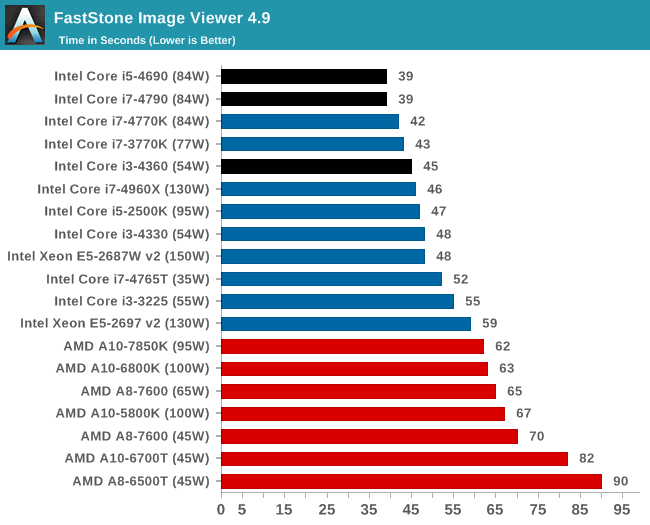
FastStone is all about the single thread speed.
Video Conversion – Xilisoft Video Converter 7: link
The XVC test I normally do is updated to the full version of the software, and this time a different test as well. Here we take two different videos: a double UHD (3840x4320) clip of 10 minutes and a 640x266 DVD rip of a 2h20 film and convert both to iPod suitable formats. The reasoning here is simple – when frames are small enough to fit into memory, the algorithm has more chance to apply work between threads and process the video quicker. Results shown are in seconds and time taken to encode.
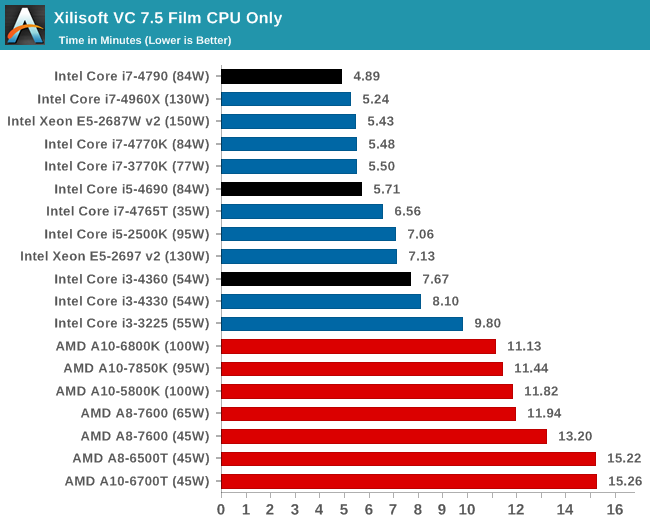
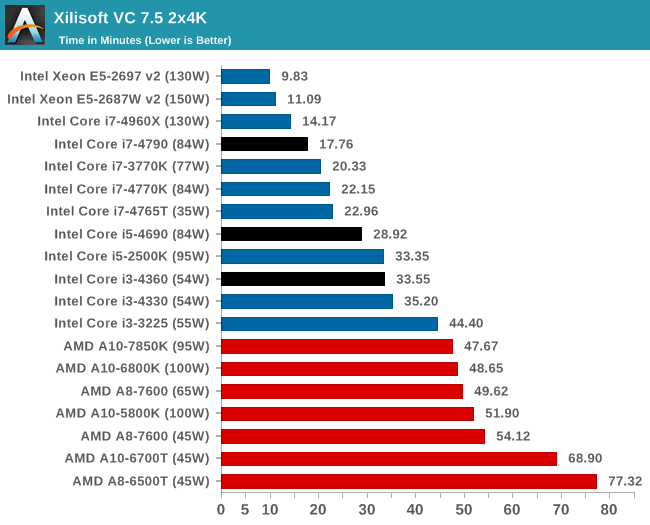
Small frames prefer more single thread MHz, whereas the dual 4K frame conversion prefers threads.
Video Conversion – Handbrake v0.9.9: link
Handbrake is a media conversion tool that was initially designed to help DVD ISOs and Video CDs into more common video formats. The principle today is still the same, primarily as an output for H.264 + AAC/MP3 audio within an MKV container. In our test we use the same videos as in the Xilisoft test, and results are given in frames per second.
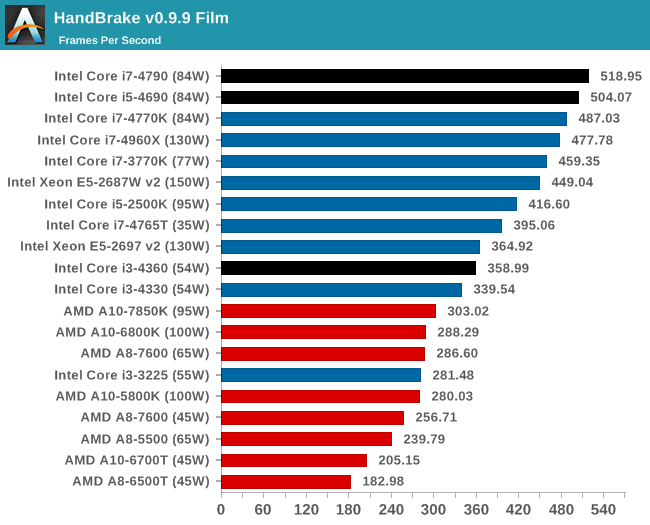
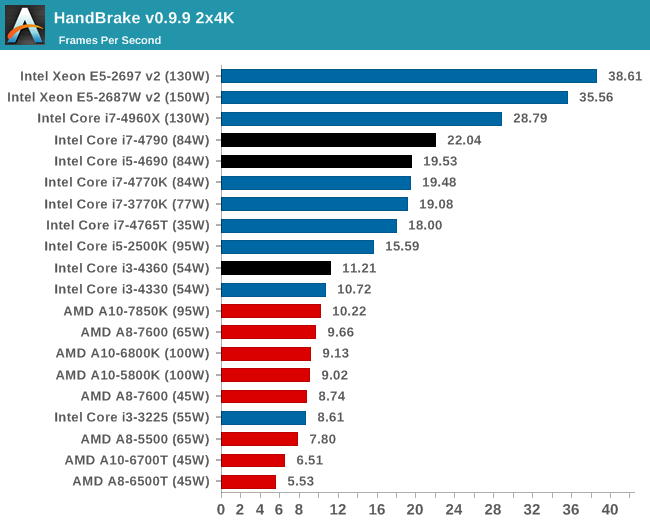
With Handbrake it would seem that it prefers actual cores rather than hyperthreading, given by the i5 and i7 being relatively close and 2x the i3.










130 Comments
View All Comments
Basilisk - Sunday, May 11, 2014 - link
While I enjoy the image of you chatting away with worms a'dangling, The Bard has his due:"Shall I bend low and in a bondman's key, With BATED breath and whispering humbleness, Say this..." [Shylock]. Billy originated the phrase, and his spelling is still considered correct... although it's a common enough error. Think of it as abated (restrained) breathing.
Informative article, however, so Thanks!
dwbogardus - Monday, May 12, 2014 - link
Really? I thought it meant breath that smelled like bait! (just kidding)coburn_c - Sunday, May 11, 2014 - link
I swear I saw a 'Death of the Desktop' and a 'PC gamers outnumber next-gen consoles' article in the same news feed last week.dave_the_nerd - Sunday, May 11, 2014 - link
So this is what you were working on?!?!10 days with no updates; you had me worried AnandTech. Thanks for the kickbutt review, as always.
davegraham - Sunday, May 11, 2014 - link
lol. in your conclusion, you say "baited breath" which would lead someone to believe that you smell of fish. what you meant to say is "bated breath" which approximates to your intent. :) great article overall Ian.IndyJaws - Monday, May 12, 2014 - link
Merchant of Venice +1FreeMan4096 - Sunday, May 11, 2014 - link
Impressive article. Bookmarking the webpage.Galatian - Sunday, May 11, 2014 - link
Ian: on page 12 dual 7970 testing in Bioshock Infinite the graph for minimum frame rates has the core i3 twice with two completely different values.Thanks anyway for the great article!
extide - Sunday, May 11, 2014 - link
"Eventually as the future of the chipset progresses, I see all these ports becoming flexible, though I would imagine we are a few years out from this." -- I actually don't think that will happen. It undoubtedly will increase the complexity of the chipset to allow the possibility for every single port to be configurable, thus increase costs. However, it is very unlikely that you would have a situation where you wouldn't want any SATA ports, or USB3 ports. Thus it seems pretty pointless to make ALL of the ports configurable. I would imagine that we will see a future with MORE configurability, but I would bet you will always see some dedicated ports.mapesdhs - Sunday, May 11, 2014 - link
If anyone's curious as to how the article's results compare to an oc'd older CPU,
here are some CB R15 numbers for a 5GHz i7 2700K (RAM @ 2133 CL10, ASUS M4E):
1-thread: 177
N-thread: 880
There's a power consumption difference of course, but the lower purchase cost of
a used 2700K makes up for it by more than an order of magnitude.
Ian.